|
|
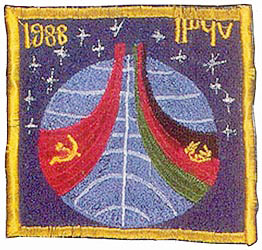
(Spacecraft: December 21, 1988)
(Polyakov: April 27, 1989)
| Crew & Mission |
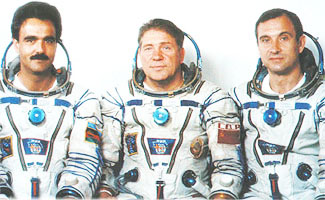
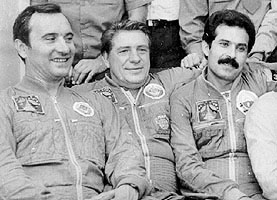
Left: Ahad, Lyakhov and Polyakov wearing training Sokols. Right: The crew in their TK-2 training suits. Note that Lyakhov is wearing a 'clipped' first generation Mir-patch.
Soyuz TM-6 was launched on August 29, 1988. The ship was commanded by Vladimir Lyakhov and carried Afghan Abdullah Ahad Mohmand for a week-long visit to the Mir station and physician Valeri Polyakov, who was heading for a long duration stay with the Titov/Manarov and Volkov/Krikalev Mir-crews.
With Russian troops withdrawing from Afghanistan, Ahad's flight was purely political. He did not even have his own national experiments aboard! Instead, Bulgarian equipment was used. The launch of Soyuz TM-6 was advanced by months in fear that the Afghan government would fall before the flight could take place. The timing of the flight caused the re-entry burn to take place at sunrise, not normally done. The outmoded horizon sensors used by the Soyuz were blinded and could not position the capsule correctly, leading to some very hairy moments for Ahad and Lyakhov.
Soyuz TM-5 (the crew's return vehicle) undocked from Mir on September 6 and ejected its crew compartment as planned. Thirty seconds before the re-entry burn, Lyakhov noticed a problem with one of the sensors. The engine was fired, however, but was shut down 60 seconds early by the computer, who was unable to determine the ship's attitude. The cosmonauts made another attempt three hours later, without re-programming their computer. They found themselves on a trajectory that would have them land in China, so Lyakhov stopped the engine manually three seconds into the burn. He then changed his mind and decided to fire it again. This time, it shut down automatically after 6 seconds.
As a result, the cosmonauts had to stay in orbit for another day, without any food. The third landing attempt on September 7 was successful. A few days after the craft's touchdown, Lyakhov admitted to reporters that he had made mistakes. Alexander Dunayev, head of the Soviet space agency Glavkosmos, said mission control was also at fault. Still, Lyakhov never returned to space.
Soyuz TM-6's third crew member, Valeri Polyakov, remained aboard Mir for another eight months. The Soyuz TM-6 capsule returned to Earth on December 21, 1988, with Mir-3 crewmembers Vladimir Titov and Musa Manarov. Polyakov himself returned to Earth aboard Soyuz TM-7 with EO-4 crew Aleksandr Volkov and Sergei Krikalev, leaving the station temporarily unoccupied.
| The Real Thing |
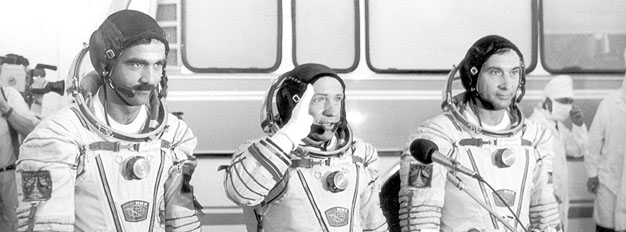
Ahad, Lyakhov and Polyakov in their flight Sokols, just before launch.
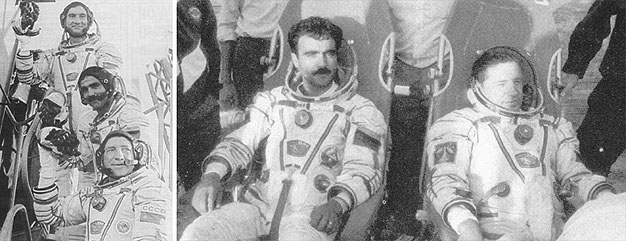
Left: The crew boarding their spacecraft on launchday. Right: Ahad and Lyakhov shortly after landing. Polyakov stayed behind on Mir and returned with TM-7 crewmembers Aleksandr Volkov and Sergei Krikalev. The Afghan seal and flag can be clearly seen on Ahad's Sokol.
The mission patch was worn on the right sleeve of the Sokols (on the right chest in pre-flight pictures). A fully embroidered CCCP-Flag patch with rounded letters was worn on the left sleeve by the Soviet cosmonauts and the Afghan Flag patch with the Cyrillic letters 'PA' ('RA', Afghanistan Republic) on the left sleeve of Ahad's Sokol. Ahad was also wearing an Afghan seal, which, like the seal on the Soviet suits, was worn on the left chest. A second generation, stylized Mir-patch was worn on the front of the suit by all three cosmonauts.

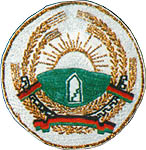
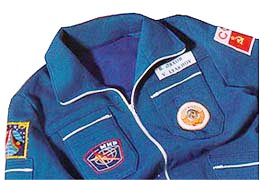
The Afghan Flag (left) and seal (center) and Lyakhov's flown PK-14 IVA-jacket (right).
We do not have inflight pictures, but we have one image of Lyakhov's PK-14 jacket, as sold in the 1993 Sotheby's auction. Polyakov was later photographed wearing his Penguin suit with a second generation, stylized Mir patch on the right pocket, a white nametag on his right upper chest, a Soviet seal on his left upper chest and a CCCP-flag (rounded letters) on his left sleeve. This does not mean he did not wear the Afghan mission patch during Ahad's stay: TM-7 cosmonauts Krikalev and Volkov were wearing the Soviet/French mission patch and a bi-lingual nametag on their Penguins when French cosmonaut Jean-Loup Chrétien was around, but switched to "standard" Mir-Penguins later during their mission.
| Variations |
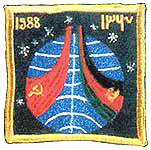
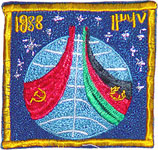
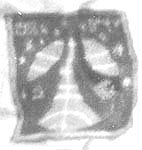
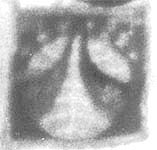
The TM-6 patch was clearly hand-made - it seems that no single patch is the same. This is especially visible in the star pattern. At left is the version as seen in the book '40 Let Kosmicheskogo Polviga' (Moscow, 2000). Note that the number of stars is different (8 instead of 14) and that the "v" in the upper right corner is smaller. The second picture shows the patch in the collection of a Russian friend of Luc van den Abeelen. It has 13 or 14 stars, which are much more horizontally aligned compared to the patch shown at the top of the page, which was part of a Presentation Patch Set for this mission. The third picture shows a detail from the actual flight Sokol of Ahad. The picture at right shows Polyakov's mission patch, which lacks at least the lower right star.
| Collecting Soyuz TM-6 |
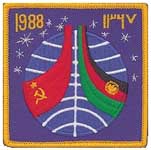
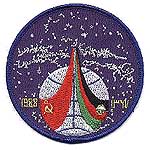
The picture of the original patch at the top of this page was part of a Presentation Patch Set for this mission and was scanned from the Sotheby's 1993 Russian Space History auction catalogue. The Afghan flag and seal were scanned from the book '40 Let Kosmicheskogo Polviga' (Moscow, 2000). Two souvenir versions of the patch exist: the Space Commerce Corporation reproduction (12 stars; left) and the Stewart Aviation version (right), which is probably based on a variation of the artwork.